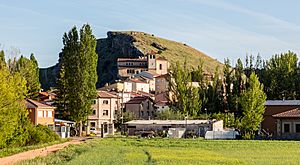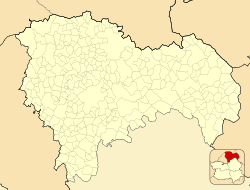Abánades facts for kids
Quick facts for kids
Abánades, Spain
|
|||
|---|---|---|---|
 |
|||
|
|||
| Country | |||
| Autonomous community | Castile-La Mancha | ||
| Province | Guadalajara | ||
| Municipality | Abánades | ||
| Area | |||
| • Total | 36.08 km2 (13.93 sq mi) | ||
| Elevation | 1,039 m (3,409 ft) | ||
| Population
(2018)
|
|||
| • Total | 53 | ||
| • Density | 1.469/km2 (3.80/sq mi) | ||
| Time zone | UTC+1 (CET) | ||
| • Summer (DST) | UTC+2 (CEST) | ||
Abánades is a small town, or municipality, in the province of Guadalajara, Spain. It's part of the Castile-La Mancha region. In 2017, about 59 people lived there, making it a quiet place with lots of space!
Contents
Population Changes in Abánades
Demographics is the study of how populations change over time. Abánades has seen its population decrease over the years. For example, in 1991, there were 128 people living there. By 2017, the population was 59. This shows a trend of fewer people choosing to live in the town.
History of Abánades
Ancient Times and Medinaceli
Hundreds of years ago, around the 900s and 1000s, a town called Medinaceli was very important. It was a strong military base that protected against Christian kingdoms. When King Alfonso VI took Medinaceli in 1104, the area of Abánades became part of his kingdom.
The first records of Abánades are from the 1300s. These documents show that Abánades was once under the rule of Medinaceli, even when Medinaceli was controlled by the Arabs. The area was later settled again about 50 years after it was taken by King Alfonso VI.
The King's Record Book
In the early 1300s, King Peter I of Castile and León ordered a special book to be made. This book was called the Becerro de las Behetrías de Castilla. It was a record of all the people and lands under the king's rule. This book helps us learn about Abánades from that time.
Abánades in the Spanish Civil War
Abánades played a part in the Spanish Civil War in March 1938. This war lasted for two years. One side, called the Nationalists, wanted to reach the Mediterranean Sea to divide the other side's forces. To help, a general named Cipriano Mera started an attack in Guadalajara.
In Abánades, a group of soldiers took a key position. After many days of intense fighting, the battle front became stable. This fight is sometimes called the "Forgotten Battle" because it's not as well-known as other battles. Many people were hurt or lost their lives during this time.
Geography of Abánades
Where is Abánades Located?
Abánades is located high up, about 1,039 meters (3,409 feet) above sea level. The highest point nearby is a mountain called Majada Ancha, which is even taller at 1,154 meters (3,786 feet). The town is surrounded by many hills, like La Tablada and El Castillo.
What is the Ground Like?
The ground in Abánades is very old, made mostly of clay. When this clay gets pressed together, it forms a type of rock called slate. Slate is very common in this area. Because there's a lot of clay, you can also find a lot of quartzite, another type of rock.
What is the Climate Like?
Abánades has a Mediterranean climate. This means the winters are usually cold, and the summers can get very hot.
Rivers and Water Sources
The Tajuña river is very important for Abánades. It's a branch of the larger Tagus river. Farmers in Abánades use the Tajuña river to water their crops. There's also a small stream called Valdelasarna brook to the north of the town. This brook also helps water some of the farmland and flows into the Tajuña river.
Monuments in Abánades
Abánades has some interesting old buildings. The Parish Church of St. Peter was built in the 1500s. There is also the Chapel of Our Lady of Mercy.
Festivals in Abánades
Abánades celebrates several local festivals throughout the year.
- In the first week of August and on September 24, the town honors its patron saint, Nuestra Señora de la Merced (the Virgin of Mercy). These festivals are very important to the community. They include games, shows, music, and dancing.
- On May 15, there are also festivities to honor Saint Isidore.
Images for kids
See also
 In Spanish: Abánades para niños
In Spanish: Abánades para niños







